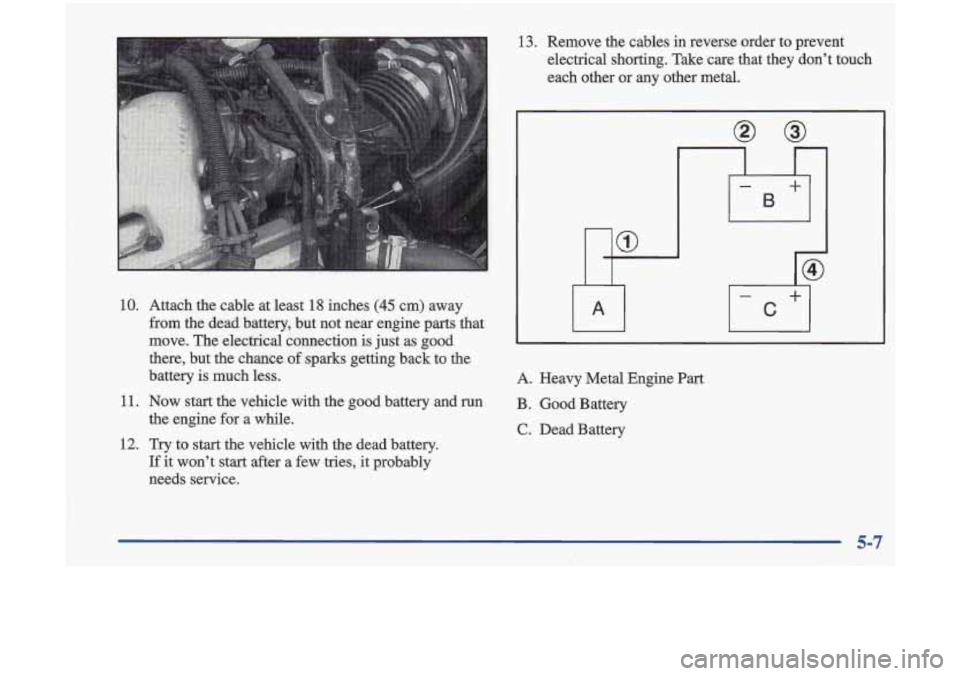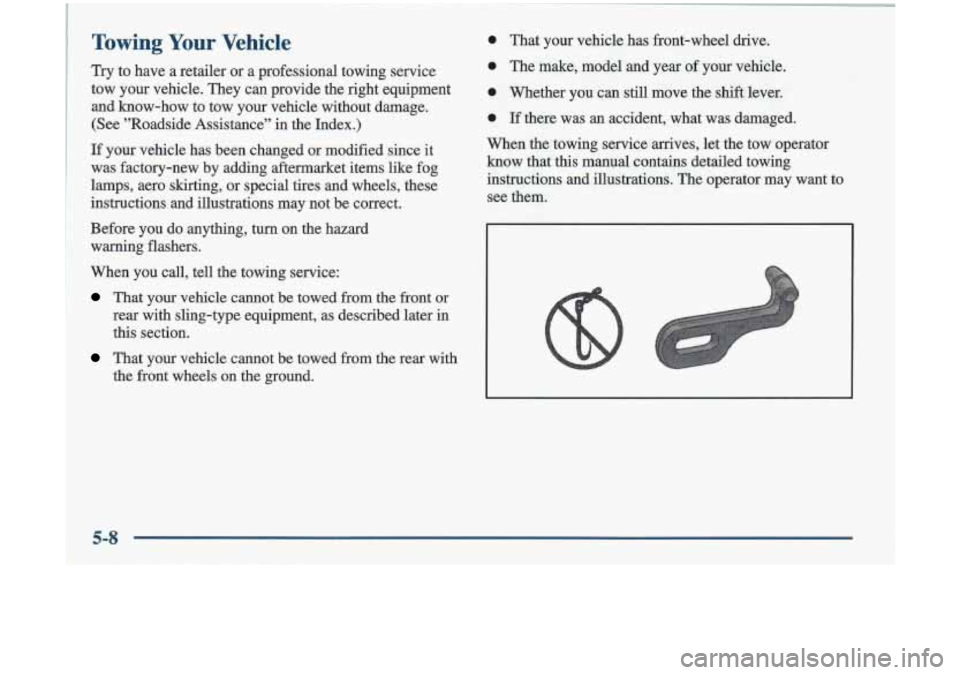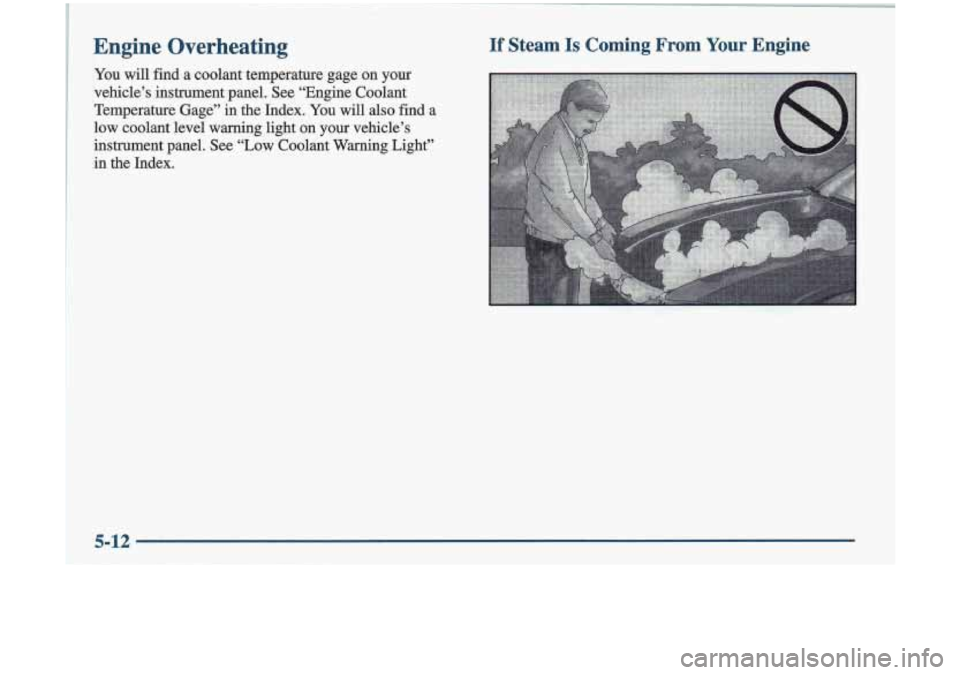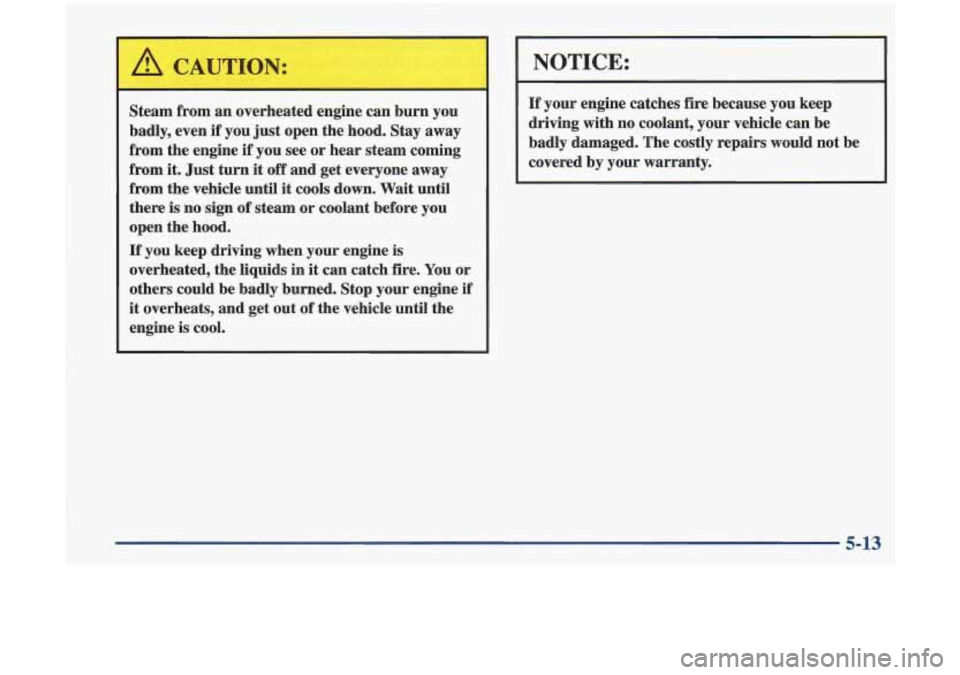Oldsmobile Cutlass 1998 Owner's Manuals
Cutlass 1998
Oldsmobile
Oldsmobile
https://www.carmanualsonline.info/img/31/9579/w960_9579-0.png
Oldsmobile Cutlass 1998 Owner's Manuals
Trending: change wheel, radio controls, boot, clock setting, towing, transmission fluid, overheating
Page 191 of 348
~ i ~
i 5. Find the positive (+) and negative (-) te
Fans or other moving engine parts can iajare you
badly. Keep your bane away from .moving parts
once the engine is running.
Page 192 of 348
Page 193 of 348
10.
11.
12.
Attach the cable at least 18 inches (45 cm) away
from the dead battery, but not near engine parts that
move. The elactrical connection
is just as goad
there, but the chance of sparks gettmg back to the
battery is much less.
Now start the vehicle with the good battery
and run
the engine for a while.
Try to start the vehicle with the dead battery.
If it won’t start after a few tries, it probably
needs service.
13. Remove the cables in reverse order to prevent
electrical shorting. Take care that they don’t touch
each other
or any other metal.
A. Heavy Metal Engine Part
B . Good Battery
C. Dead Battery
I,
5-7 I
Page 194 of 348
Towing Your Vehicle
Try to have a retder or a professional towing service
tow your vehicle. They can provide the right equipment
and
know-how to tow your vehicle without damage.
(See ”Roadside Assistance”
in the Index.)
If your vehicle has been changed or modified since it
was factory-new by adding aftemarket items like
fog
lamps, aero skirting, or special tires and wheels, these
instructions and illustrations may not be correct.
Before you do anything,
turn on the hazard
warning flashers.
When you call, tell the towing service:
That your vehicle cannot be towed from the front or
rear with sling-type equipment, as described later
in
this section.
That your vehicle cannot be towed from the rear with
the front wheels on the ground.
Page 195 of 348
To help avoid injury to you or others:
--
A vehicle can fall from a car carrier if it isn't
e
e
e
0
e
e
Never let passengers ride in a vehicle that is
bemg towed.
Never tow faster than safe or posted,speeds.
Never tow with damaged parts not
fully secured.
Never get under your vehicle after
it has
been lifted by the tow truck.
Always secure the vehi'cle on each side with
separate safety chains when towing
it.
Never use J-hooks. Use T-hooks instead.
5-9
Page 196 of 348
Front Towing
NOTICE:
Do not tow with sling-type equipment or fascia
damage will occur. Use wheel-lift or car-carrier
equipment. Additional ramping may be required
for car-carrier equipment. Use safety chains and
wheel straps.
NOTICE: (Continued) NOTICE:
(Continued)
Towing
a vehicle over rough surfaces could
damage
a vehicle. Damage can occur from
vehicle to ground or vehicle to wheel-lift
equipment. To help avoid damage, install
a
towing dolly and raise the vehicle until adequate
clearance
is obtained between the ground and/or
wheel-lift equipment.
Do not attach winch cables or J-hooks to
suspension components when using car-carrier
equipment. Always use T-hooks inserted in
the T-hook slots.
Page 197 of 348
Rear Towing
I NOTICE:
Do not tow with sling-type equipment or the rear
bumper valance
will be damaged. Use wheel-lift
or car-carrier equipment. Additional ramping
may be required for carcarrier equipment. Use
safety chains and wheel
straps.
i NOTICE: (Continued) NOTICE: (Continued)
Towing a vehicle over rough surfaces could
damage
a vehicle. Damage can occur from
vehicle to- ground
or vehicle to wheel-lift
equipment. To help avoid damage, install a
towing dolly and raise the vehicle until adequate
clearance is obtained between the ground and/or
wheel-lift equipment.
Do not attach winch cables or J-hooks to
suspension components when using car-carrier
equipment. Always use T-hooks inserted in
the T-hook slots.
5-11
Page 198 of 348
Engine Overheating
You will find a coolant temperab Ire gage on
vehicle’s instrument panel. see “Engine Coo
If Steam Is Coming From Your Engine
your
dant
Temperature Gage”
in the Index. You will also find a
low coolant level waming light on your vehicle’s
instrument panel. See
“LOW Coolant Warning Light”
in the Index.
5-12
Page 199 of 348
Steam from an overheated engine can burn you
badly, even if you just open the hood. Stay away
from the engine if you see or hear steam coming
from it. Just turn it off and get everyone away
from the vehicle until it cools down. Wait until
there is no sign of steam or coolant before you
open the hood.
If you keep driving when your engine is
overheated, the liquids in it can catch fire. You or
others could be badly burned. Stop your engine
if
it overheats, and get out of the vehicle until the
engine is cool.
~~ ~
NOTICE:
If your engine catches fire because you keep
driving with no coolant, your vehicle can be
badly damaged. The costly repairs would not be
covered by your warranty.
5-13
Page 200 of 348
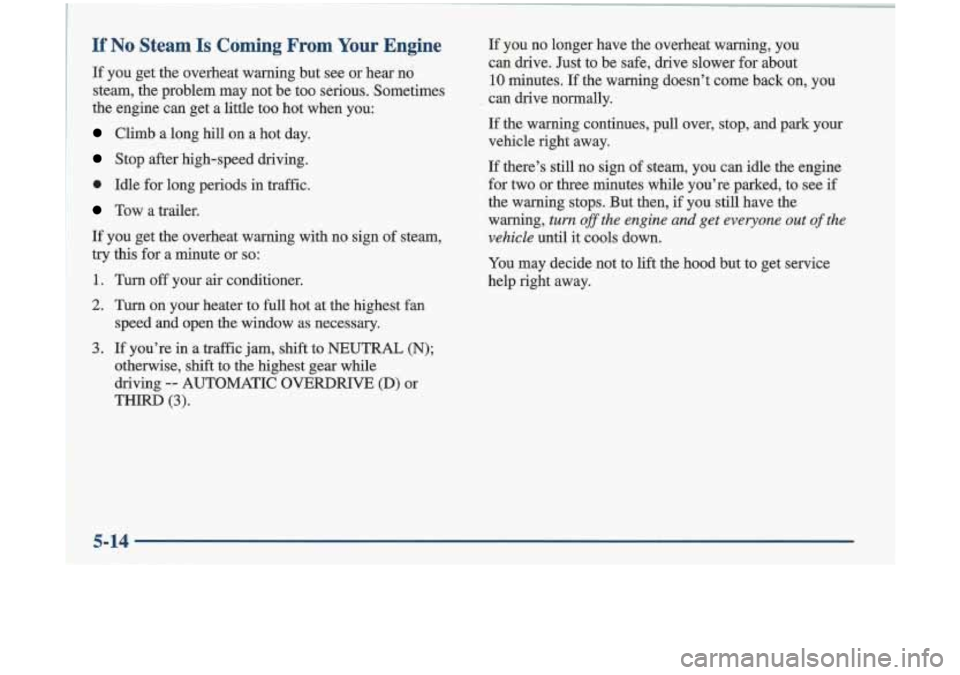
If No Steam Is Coming From Your Engine
If you get the overheat warning but see or hear no
steam, the problem may not be too serious. Sometimes
the engine can get a little too hot when you:
Climb a long hill on a hot day.
Stop after high-speed driving.
a Idle for long periods in traffic.
Tow a trailer.
If you get the overheat warning with no sign of steam,
try this for a minute
or so:
1. Turn off your air conditioner.
2. Turn on your heater to full hot at the highest fan
speed and open the window as necessary.
3. If you’re in a traffic jam, shift to NEUTRAL (N);
otherwise, shift to the highest gear while
driving
-- AUTOMATIC OVERDRIVE (D) or
THIRD
(3).
If you no longer have the overheat warning, you
can drive. Just to be safe, drive slower for about
10 minutes. If the warning doesn’t come back on, you
, can drive normally.
If the warning continues, pull over, stop, and park your
vehicle right away.
If there’s still no sign of steam, you can idle the engine
for
two or three minutes while you’re parked, to see if
the warning stops. But then, if you still have the
warning,
turn off the engine and get everyone out of the
vehicle
until it cools down.
You may decide not to lift the hood but to get service
help right away.
5-14
Trending: change wheel, heater, park assist, power steering, radiator cap, sensor, technical specifications


